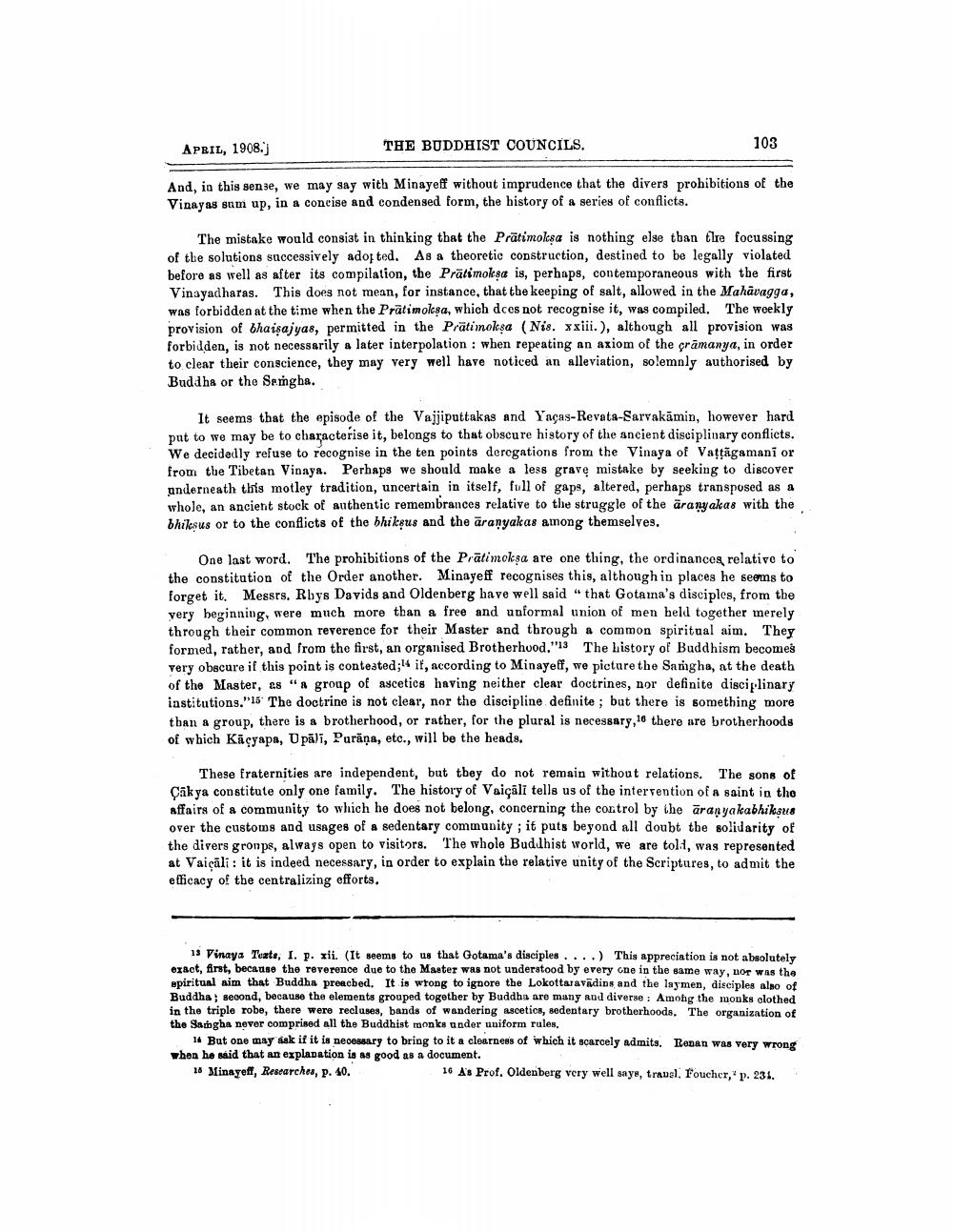________________
APRIL, 1908.)
THE BUDDHIST COUNCILS.
103
And, in this sense, we may say with Minayeff without imprudence that the divers prohibitions of the Vinayas sum up, in a concise and condensed form, the history of a series of conflicts.
The mistake would consist in thinking that the Prātimoksa is nothing else than the focussing of the solutions successively adopted. As a theoretic construction, destined to be legally violated before as well as after its compilation, the Prātimoksa is, perhaps, contemporaneous with the first Vinayad haras. This does not mean, for instance, that the keeping of salt, allowed in the Mahāvagga, was forbidden at the time when the Prätimolsa, which does not recognise it, was compiled. The weekly provision of bhaisajyas, permitted in the Prätimoksa (Nis. xxiii.), although all provision was forbidden, is not necessarily a later interpolation : when repeating an axiom of the grāmanya, in order to clear their conscience, they may very well have noticed an alleviation, solemnly authorised by Buddha or the Semgha.
It seems that the episode of the Vajjiputtakas and Yncas-Revata-Sarvakämin, however hard put to we may be to characterise it, belongs to that obscure history of the ancient disciplinary conflicts. We decidedly refuse to recognise in the ten points deregations from the Vinaya of Vattāgamani or from the Tibetan Vinaya. Perhaps we should make a less grave mistake by seeking to discover underneath this motley tradition, uncertain in itself, full of gaps, altered, perhaps transposed as a whole, an ancient stock of authentic remembrances relative to the struggle of the āranyakae with the bhilesus or to the conflicts of the bhikṣus and the āranyakas among themselves.
One last word. The prohibitions of the Prātimokşa are one thing, the ordinances relative to the constitution of the Order another. Minayeff recognises this, although in places he seems to forget it. Messrs. Rbys Davids and Oldenberg have well said " that Gotaina's disciples, from the very beginning, were much more than a free and unformal union of men held together merely through their common reverence for their Master and through a common spiritual aim. They formed, rather, and from the first, an organised Brotherhood."'13 The history of Buddhism becomes very obscure if this point is conteated; it, according to Minayeff, we picture the Sarigha, at the death of the Master, es "& group of ascetics having neither clear doctrines, nor definite disciplinary institutions."15 The doctrine is not clear, nor the discipline definite; but there is something more than a group, there is a brotherhood, or rather, for the plural is necessary, is there are brotherhoods of which Küçyapa, Upāli, Parāņa, etc., will be the heads.
These fraternities are independent, but they do not remain without relations. The sons of Cakya constitute only one family. The history of Vaicāli tells us of the intervention of a saint in the affairs of a community to which he does not belong, concerning the control by the āranyakabhiksus over the customs and usages of a sedentary community ; it puts beyond all doubt the solidarity of the divers gronps, always open to visitors. The whole Buddhist World, we are told, was represented at Vaicāli: it is indeed necessary, in order to explain the relative unity of the Scriptures, to admit the efficacy of the centralizing efforts.
13 Vinaya Tuxte, I. p. xii. (It seems to us that Gotama's disciples ....) This appreciation is not absolutely exact, first, because the reverence due to the Master was not understood by every one in the same way, nor was the spiritual aim that Buddha preacbed. It is wrong to ignore the Lokottaravādins and the laymen, disciples also of Buddha, second, because the elements grouped together by Buddha are many and diverse: Among the monks clothed in the triple robe, there were recluses, bands of wandering ascetics, sedentary brotherhoods. The organization of the Samgha never comprised all the Buddhist monks under uuif
14 But one may sak if it is necessary to bring to it a clearness of which it scarcely admits. Ronan was very wrong when he said that an explanation is as good as a document. 18 Minayeff, Researches, p. 40.
16 A's Prot, Oldenberg very well says, travel, Foucher, p. 231.




